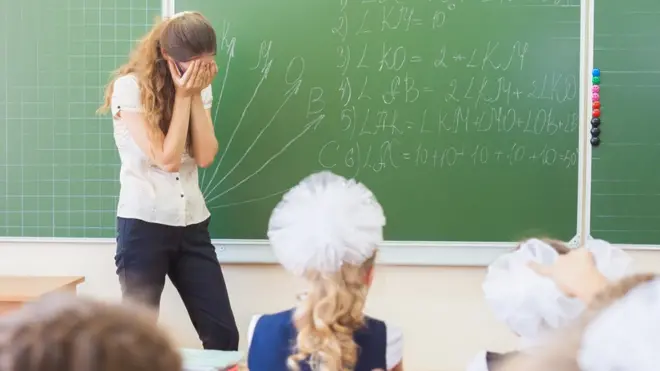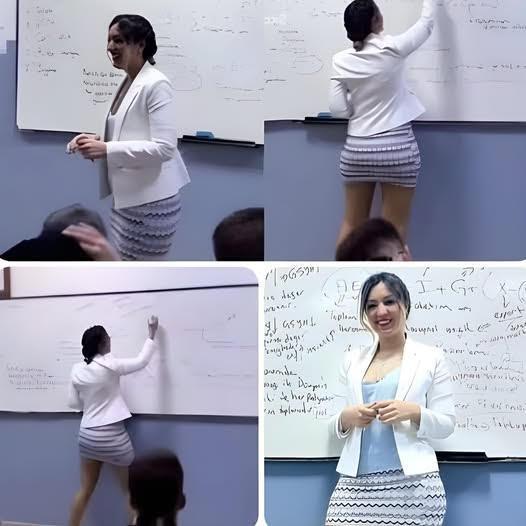In recent weeks, a viral video featuring a woman teaching in front of a whiteboard has circulated widely on social media platforms. The video, taken in what appears to be a classroom, shows a professionally dressed woman explaining concepts on a whiteboard, accompanied by misleading and inappropriate captions claiming the teacher was “provoking” students.
However, there is no evidence or credible source confirming any wrongdoing or misconduct by the individual shown. The woman appears to be engaged in standard classroom instruction, wearing attire that, while modern and fitted, does not violate common workplace or institutional norms for professional settings.
Teaching Attire: A Matter of Cultural and Institutional Norms
Professional appearance in teaching roles varies based on geographic region, school policy, and subject matter. There is no universal dress code for educators. However, most institutions encourage attire that reflects:
-
Professionalism and respect for the educational environment
-
Comfort for long teaching sessions
-
Suitability based on climate and setting
The woman in the video is wearing a fitted blazer and knee-length skirt — a style common in many corporate and academic settings worldwide. There is nothing inherently inappropriate or unprofessional about the outfit in the context of the classroom as seen in the video.

Why Context Matters in Viral Media
One of the primary challenges in the age of viral content is the lack of context. A 2022 study by the Reuters Institute for the Study of Journalism found that more than 60% of users shared or reacted to viral content based only on the headline or thumbnail, often without verifying the content.
In cases like this, a teacher conducting a normal lesson may become the subject of misinformation simply because of the way a video is edited or captioned.
This not only affects the individual’s reputation but can have broader consequences:
-
Harassment or cyberbullying
-
Employment-related misunderstandings
-
Mental health impacts due to public scrutiny
(Source: Reuters Institute Report, 2022)

The Role of Media Literacy in Education
Educators and students alike must be equipped with media literacy skills to critically analyze the content they consume and share. Key principles include:
-
Verify before sharing – Always check the source and context.
-
Understand consent – Ask whether the person featured consented to the footage being recorded or posted.
-
Evaluate the tone – Headlines using exaggerated or emotional language often distort the truth.
-
Recognize digital manipulation – Images or videos can be edited to suggest things that didn’t occur.
Organizations such as Common Sense Media and News Literacy Project provide excellent resources for teaching students how to navigate online spaces responsibly.

Legal Protections and Digital Rights
In many countries, including the United States, European Union, and Vietnam, individuals have legal protections against defamation, harassment, and the non-consensual sharing of media. Posting or repurposing a classroom video with misleading captions could be grounds for:
-
Defamation lawsuits
-
Takedown notices under DMCA or EU Copyright Directive
-
Investigations for harassment or workplace misconduct
Employers, especially educational institutions, are increasingly aware of these challenges and may initiate legal action when faculty members are misrepresented online.
(Sources: U.S. Digital Millennium Copyright Act, GDPR and Digital Privacy)

Constructive Use of Classroom Media
When used ethically, videos of classroom teaching can be a powerful tool for:
-
Training new educators
-
Documenting successful teaching methods
-
Improving student engagement through review
-
Encouraging best practices in pedagogy
However, recording or sharing such media should follow institutional guidelines and be based on mutual consent and respect.
Many universities now include media guidelines in faculty handbooks, ensuring that both students and teachers understand how educational content may be recorded and used.

Conclusion: Respect, Context, and Accuracy in Online Education Media
The viral video of the female educator has become a case study in how contextless content and misleading captions can distort reality. The woman in the clip appears to be performing her role professionally — instructing a class while dressed in workplace-appropriate attire.
Claims that she was removed from her position or engaged in misconduct are not supported by any credible source. Spreading such claims can harm individuals, violate platform rules, and undermine public trust in educators.
As consumers of digital media, we all share a responsibility to ensure the content we share is truthful, respectful, and aligned with community and legal standards.



